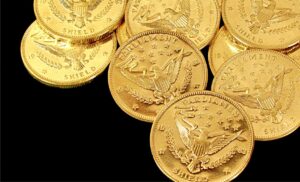What kind of money is a gold certificate considered to be? Commodity, Fiat, Representative Currency?
Gold certificates are a form of representative currency, a financial instrument that represents ownership of a specified amount of gold.
They were widely used in the past as a means of transacting business, especially in the era before modern currency systems existed.
In terms of the type of money that they represent, gold certificates can be considered a form of representative currency, as they are backed by a physical commodity.
However, the precise classification of gold certificates can depend on a number of factors, including the legal and economic context in which they are used.
It is important to note that gold certificates are no longer widely issued and are primarily considered a historical artifact rather than a practical investment option.

Commodity Money
Commodity money is a type of currency that has intrinsic value based on the material it is made of, rather than being backed by a government or financial institution.
Historically, commodity money has been used in many societies, such as salt, gold, silver, or other precious metals, as well as commodities such as livestock or grain.
Commodity money is valuable because it has a practical use or value beyond being used as a medium of exchange. For example, gold and silver can be used for jewelry or industrial purposes, while livestock and grain can be consumed or used for farming.
The value of commodity money is determined by the supply and demand for the material it is made of, as well as its quality and purity.
In contrast, fiat money, which is the type of currency used in most modern economies, has value because of government backing and the belief that it can be exchanged for goods and services.
Fiat Money

Fiat money, on the other hand, is a type of currency that is not backed by a physical commodity, but rather by the government’s promise to pay the bearer.
Modern currencies, such as the US dollar or the Euro, are examples of fiat money. Gold certificates are not considered fiat money, as they are backed by a physical commodity rather than by the government’s promise to pay.
Representative Currency
A representative currency is a type of money that represents ownership of a physical commodity, without necessarily having any inherent value in and of itself.
Gold certificates are considered a form of representative currency, as they represent ownership of a specific amount of gold, but do not have any intrinsic value beyond that.
Commodity vs Representative Currency
Commodity money and representative currency are both forms of currency, but they differ in their underlying value and how they are backed.
What is Commodity Money?
Commodity money is a type of currency that has intrinsic value based on the material it is made of. For example, gold, silver, and other precious metals have been used as commodity money throughout history.
The value of commodity money is determined by the supply and demand for the material it is made of, as well as its quality and purity.
Commodity money has value beyond its use as a medium of exchange, as it can also be used for other purposes, such as jewelry or industrial uses.

What is Representative Currency?
Representative currency, on the other hand, is a type of currency that is backed by a physical asset or a promise to pay a certain amount of money.
Representative currency includes things like paper money or digital currency, which are not inherently valuable on their own, but are backed by a physical asset or a promise to pay.
For example, in the past, paper money was backed by gold or silver reserves held by a central bank.
The Difference Between Commodity and Respresentaive currency.
The key difference between commodity money and representative currency is that commodity money has intrinsic value, while representative currency is valuable only because of the asset or promise that backs it.
Another important distinction is that commodity money has a fixed supply, whereas representative currency can be created or destroyed by a central bank or other financial institution.
In summary, commodity money has intrinsic value based on the material it is made of, while representative currency is valuable because of the asset or promise that backs it.

How to buy gold certificates
It’s important to note that gold certificates are no longer widely issued, and most existing certificates are considered collectible items rather than financial instruments.
As such, buying gold certificates can be a complex and difficult process, and is not recommended for most investors.
However, if you are interested in purchasing gold certificates, there are a few options available:
- Auctions: Gold certificates may be sold at auction houses that specialize in rare and collectible items, such as Sotheby’s or Christie’s. However, the prices for these certificates can be quite high, and there is no guarantee of the certificate’s authenticity or value.
- Dealers: There are a number of dealers who specialize in rare and collectible financial instruments, including gold certificates. These dealers may be able to help you locate and purchase certificates, but again, the prices can be high and the authenticity of the certificates may be difficult to verify.
- Online marketplaces: There are several online marketplaces, such as eBay or Amazon, where gold certificates may be available for purchase. However, it is important to exercise caution when buying items from these platforms, as there is a risk of counterfeit or fraudulent items being sold.
Gold Investing Tips
In general, it is recommended that investors who are interested in owning gold should consider purchasing physical gold, such as gold coins or bullion, rather than gold certificates.
Investing in gold is a smart way to safeguard your wealth and prepare for economic uncertainty. Our latest article covers the top 8 ways to invest in gold, so you can start building your financial future today.
Physical gold provides direct ownership of the precious metal and can be easily stored and transported, making it a more practical and accessible investment option.

Additionally, physical gold is often considered a hedge against inflation and economic uncertainty, making it a popular choice for investors seeking to diversify their portfolios and protect against market volatility.
Discover the top online stores to buy gold and take advantage of the convenience and security of online shopping for this precious commodity – check out this insightful article now
Physical Gold Vs Gold Certificates
While gold certificates can have some value as a form of historical or collectible item, they are generally not considered to be a good investment compared to physical gold.
This is because gold certificates do not actually provide ownership of physical gold, butrather represent ownership.
This means that investors who hold gold certificates may not actually have access to the physical gold that the certificates represent.
In contrast, physical gold provides investors with direct ownership of the precious metal, which can be stored and transported as desired.
Physical gold can also be used in a variety of ways, such as in jewelry, electronics, and other industrial applications, which can add to its value.
Additionally, physical gold is often considered to be a hedge against inflation and economic uncertainty, making it a popular choice for investors seeking to diversify their portfolios and protect against market volatility.
Investing in physical gold is a smart way to diversify your portfolio and protect your wealth. Our latest article covers everything you need to know to get started, including tips for buying, selling, and storing your gold. Click here to learn more.

Other Forms of Gold Investing
In addition to physical gold, there are other forms of gold investing that may be worth considering.
These include gold exchange-traded funds (ETFs), which allow investors to buy shares in a fund that holds physical gold, as well as gold mining stocks and mutual funds that invest in gold-related companies.
However, it is worth noting that these forms of gold investing do come with their own risks and potential drawbacks.
For example, gold ETFs and mutual funds may not provide direct ownership of physical gold, and may be subject to counterparty risk and other factors that can impact their value.
Gold mining stocks can also be subject to factors such as geopolitical risks and fluctuations in commodity prices, which can impact their performance.
Join me on M1 Finance, my go-to platform for buying stocks and ETFs – especially gold ETFs – and take control of your investment portfolio today!

Conclusion
In summary, gold certificates can be considered a form of representative currency that represent ownership of physical gold, but are not necessarily a good investment compared to physical gold.
Physical gold provides investors with direct ownership of the precious metal, which can be stored and transported as desired, and is often considered to be a hedge against inflation and economic uncertainty.
While there are other forms of gold investing available, investors should carefully consider the risks and potential drawbacks associated with each option before making a decision.
